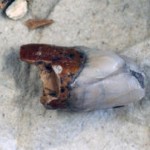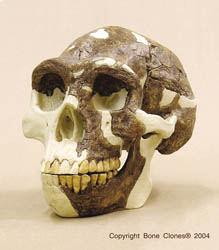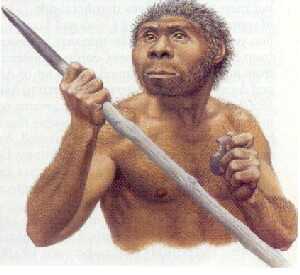
May 27, 2011

An intriguing discovery has been made at a Swedish museum.
Unique canine tooth from Peking man found
Fossils from so-called Peking man are extremely rare, as most of the finds disappeared during World War II. A unique discovery has been made at the Museum of Evolution at Uppsala University—a canine tooth from Peking Man, untouched since it was dug up in the 1920s in China.
“This is an absolutely incredible find. We and our Chinese colleagues are overwhelmed. With today’s technology, a canine tooth that has not been handled can tell us so much more than in the past, such as what they ate,” says Per Ahlberg, professor of evolutionary developmental biology at Uppsala University.Swedish paleontologists were the first scientists to go to China in the early 20th century, and they carried out a series of expeditions in collaboration with Chinese colleagues. They found large numbers of fossils of dinosaurs and other vertebrates. The material was sent to Sweden and the well-known paleontologist Carl Wiman, who identified and described the fossils. But when the direction of research changed after Wiman’s death, 40 cartons were left unopened and forgotten—until know. Over the last few weeks they have been opened by Per Ahlberg, his colleague Martin Kundrát, and Museum Director Jan Ove Ebbestad, who had drawn attention to the cartons in the storeroom at the Museum of Evolution.
In the past week they have gone through the material together with leading Chinese paleontologists from the Beijing Institute of Vertebrate Paleontology and Paleoanthropology, who were excited when their Swedish colleagues contacted them. The Museum of Evolution has the best collection of Chinese fossils of dinosaurs and other vertebrates outside of China, and the contents of the 40 cartons further enhance the value of the collection.
The fossil material comes from several different areas in China. In Zhoukoudian, southwest of Beijing, a canine tooth was found from Homo erectus, that is, Peking man. Then rich finds were made of skulls and other skeletal parts, but all of this disappeared in a mysterious way during World War II. All that remains in China today are five teeth and a few pieces of skull bone that were found in the 1950s and 1960s. So the three teeth from Peking man at the Museum of Evolution have been regarded as being among the most valuable parts of the collection. And now they have uncovered a fourth tooth—and it is untouched.
According to Professor Liu Wu from the Chinese Academy of Sciences, it is a fractured, but otherwise well-preserved canine tooth.
“This is an extremely important find. It is the only canine tooth in existence. It can yield important information about how Homo erectus lived in China,” he says.
The tooth is to be examined with modern technology. By studying how the tooth was worn down and looking at possible microscopic mineral granules from plant remains, it may be possible to puzzle out what Peking man ate. Combining this with the other material in the cartons, these scientists hope to be able to reconstruct some of the plant and animal life that existed in Peking man’s environment.
Release from Uppsala University, by Anneli Waara.

Tooth from Homo erectus found at the Museum of Evolution, Uppsala University. (Credit: Uppsala University)
The first fossils of the Homo erectus species were found on Java, Indonesia, in 1892 by Eugène Dubois, and thus called “Java Man” (originally Pithecanthropus erectus).
Nearly 30 years later, in 1923-27, more Homo erectus fossils were found thousands of miles away during excavations of the Zhoukoudian (Chou K’ou-tien) cave system just outside of Beijing, China, which was called Peking back then, and thus they are called the “Peking Man” fossils. They were initially classified as Sinanthropus pekinensis and Pithecanthropus pekinensis.
Today, Pithecanthropus erectus, Pithecanthropus pekinensis, and Sinanthropus pekinensis are considered examples of Homo erectus.

The original reconstruction of Peking Man was prepared by Dr. F. Weidenreich and Mrs. Lucille Swan in 1937 from the fossil remains of several different individuals found in the caves at Zhoukoudian, China. The Bone Clones replica of the Peking Man is easily obtainable today.
But where are the originals?
One of the most enduring mysteries of paleoanthropology is “What happened to the Peking Man?”
Fossils of Peking Man were placed in the safe at the Cenozoic Research Laboratory of the Peking Union Medical College. Eventually, in November 1941, secretary Hu Chengzi packed up the fossils so they could be sent to USA for safekeeping until the end of the war. They vanished en route to the port city of Qinghuangdao. They were probably in possession of a group of US marines whom the Japanese captured when the war began between Japan and the USA.
Various parties have tried to locate the fossils, but so far they have been without result. In 1972, a US financier Christopher Janus promised a $5,000 (USD) reward for the missing skulls; one woman contacted him, asking for $500,000 (USD) but she later vanished. In July 2005, the Chinese government founded a committee to find the bones to coincide with the 60th anniversary of the end of World War II. They remain missing.
There are various theories of what might have happened, including a theory that the bones sank with the Japanese ship Awa Maru in 1945.
Will this new discovery from Sweden lead to future insights into Peking Man fossil finds? Only time will tell.

Homo erectus
About Loren Coleman
Loren Coleman is one of the world’s leading cryptozoologists, some say “the” leading living cryptozoologist. Certainly, he is acknowledged as the current living American researcher and writer who has most popularized cryptozoology in the late 20th and early 21st centuries.
Starting his fieldwork and investigations in 1960, after traveling and trekking extensively in pursuit of cryptozoological mysteries, Coleman began writing to share his experiences in 1969. An honorary member of Ivan T. Sanderson’s Society for the Investigation of the Unexplained in the 1970s, Coleman has been bestowed with similar honorary memberships of the North Idaho College Cryptozoology Club in 1983, and in subsequent years, that of the British Columbia Scientific Cryptozoology Club, CryptoSafari International, and other international organizations. He was also a Life Member and Benefactor of the International Society of Cryptozoology (now-defunct).
Loren Coleman’s daily blog, as a member of the Cryptomundo Team, served as an ongoing avenue of communication for the ever-growing body of cryptozoo news from 2005 through 2013. He returned as an infrequent contributor beginning Halloween week of 2015.
Coleman is the founder in 2003, and current director of the International Cryptozoology Museum in Portland, Maine.
Filed under Almas, Breaking News, CryptoZoo News, Fossil Finds